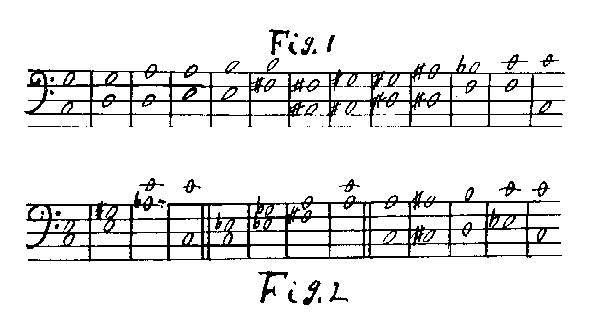
TERMS OF HARMONY USED IN PIANO TUNING
Musical pitch is of two kinds, Abstract and Relative. Abstract pitch is the effect produced by any single musical tone, without reference to any other.
By relative pitch we refer to not less than two musical tones, the second of which is a recognizable distance, higher or lower than the first.
By the key of a piece of music we refer to the abstract pitch of its tonic (first tone).
The names of the degrees of the scale are primes, seconds, thirds, fourths, fifths, sixths, sevenths and eighths or octaves.
The degrees of the scale obtain their names according to the numerical distance, the second is from the first, and are called primes, seconds, etc.
In beginning the study of piano tuning our work consisted exclusively to that of pitch. We cannot depend upon pitch for perfect tuning, although considerable accuracy might be attained.
In order to tune correctly we combine pitch with beats.
Beats do not indicate pitch: they only indicate impurity.
The following is an example on the aim of tuning a circle of perfect fifths and fourths:
As the result of this tuning the octave will be found sharp. See Fig. 1. Page 3.

Example of tuning perfect major and minor thirds. See Fig. 2. Page 3.
Intervals greater than the ninth are usually spoken of as within the octave. A note ten degrees from a given tone is usually called a third instead of a tenth The minor second or semitone is the smallest interval used.
But for the sake of classification some musicians speak of the unison as the smallest interval. The propriety of doing this is questioned by some, as an interval is the difference in pitch of tone, and a unison consists of two or more tones on the same pitch. For example, C sharp and D flat.
...
Temperament
Temperament is the most important subject in Piano-Forte tuning
A simple definition of which is, such a distribution of the imperfections of the octave among the different intervals within the octave that the semltones are made equal.
The system used is the third system which consists of four series of three major thirds each.
First series C to E, E to G sharp, A flat to C.
Then tune down a fifth from the upper note of the second major third of the first series. G sharp - C sharp which becomes the basis of the second series.
Second series. D flat to F, F to A, A to C sharp.
Then tune down a fifth from the upper note of second major third of second series which is the basis of third series. A down to D.
Third series. D to F sharp, F sharp to A sharp, B flat to D. Tune down a fifth from upper note of second major third of third series, B flat - E flat which is the basis of fourth series.
Fourth series. E flat to G, G to B, B to D sharp.
The minor thirds carry an imperfection equal to more than three times that found in fourths and fifths, while the major thirds carry an imperfection of more than twice that found in fourths and fifths.
We have now established the following principles: All major thirds, perfect fourths, and major sixths are tempered by expansion from the pure point.
All minor thirds and perfect fifths are tempered by contraction from the pure point.
Fourths and fifths contain one-twelfth al the imperfections within the octave. Minor thirds about one-fourth. Major thirds about one-third. The actual increase of each major third over its predecessor is a small amount, five twelfths of a beat per second.
The basis or the second, third and fourth sets of major thirds is established by tuning down a fifth from the upper note of the second major third of the previous set.
The minor thirds carry an imperfection equal to more than three times that found in fourths and fifths, while the major thirds carry an imperfection of more than twice that found in fourths and fifths.
The proof of an octave: a minor third above the lower note should beat the same as the major sixth below the upper note.
Additional proofs of perfect octaves: fourths and fifths below the upper note also double octaves and tenths.
The proof of a perfect fifth: a minor third above the lower note should beat the same as a major third below the upper note.
The proof of a tempered fourth: the major sixth below the upper note should beat one and one-half beats faster than the major third below the lower note.
The proof or a tempered fifth: the minor third above the lower note should beat a trifle faster than the major third below the upper note.
The temperament is set in the small octave. The octaves shove are one lined, two lined, three lined, four lined, and five lined C.
Those below are great, contra and sub-octave.
Write proof of temperament on the staff. Names and characters of temperament.
X expansion.
[triangle] contraction.
[square] faster.
[circle] equal.
All proofs are written in quarter notes.
...
Harmonics. beats. Mathematical Formula,
Etc.
The pitch of a vibrating string depends upon three conditions. viz.: Length, weight and tension. Increase the weight or decrease the tension and the pitch is lowered, or vice versa the pitch will be raised. All of the above conditions are made use or in the construction of the pianoforte scale.
The tone produced by tbs vibration of a string is not that or a single pitch only, as the uneducated ear would lead one to suppose, but is a combined effect of many tones.
The most noticeable of all is, however, the lowest in pitch and is named the fundamental. All above which are called harmonics or over tones.
To enable a string to vibrate it must be stretched between two rigid points or bridges which constitute the real end or the string.
Taking hold of the centre of the string and plucking it to one side it immediately springs back to its position of rest, passes it, returns and thus vibrates, always making a double movement for one vibration. From point of rest out to the right and back to the point of rest, then to the left and back to the point or rest like a pendulum.
The vibration of the string alone is not sufficient to produce a sound, hence it is necessary to have a proper sound-board for stringed instruments, as it is not the strings that throw the air into sonorous vibrations, but the large surface of the sound-board over which the strings are arranged and the air inclosed by this surface, so that the volume of tone almost wholly depends upon the size and quality of the sound-board.
The wood of the sound-board ought to be spruce and of the most perfect elasticity.
If in one lined C we had two beats, two lined C with the same error would have four beats. The character of roughness alters with the number of beats.
Slow beats give a coarse kind of roughness and quick tones a finer, but more cutting roughness, so that we are able with high tones to produce more rapid audible beats than with low tones.
High tones in a chord are much more sensitive to an error in tuning than low ones. The beats of a whole tone in the lower part of the piano are very distinct and powerful which are scarcely audible at the upper limit.
The major and minor thirds in the middle of the scale scarcely show any roughness, but are decidedly rough in the lower octave.
A musical tone or sound is uniform, which remains unaltered as long as it exists.
Hence we anticipate a regular motion of the air which is excited by an equally regular motion of the vibrating string whose impulses are conducted to the ear by the air.
The movement of the air from a vibrating string spreads out in all directions, just as the waves an a sheet of calm water when a stone is thrown into it.
Musical tones are distinguished first by their force: second by their pitch: third by their quality.
We easily recognize that the force of a vlbrating string is greatest when first struck and with a test blow the vibrations are large enough to be seen with the eye, and the tone is loudest, when immedlately they become smaller and the tone weaker.
Hence loudness must depend upon the size of vibrations.
Experience teaches that musical tones of the same pitch can be produced upon most kinds of instruments in a great variety of ways, but for the same pitch the air thus excited must be periodic to excite in us a musical tone. If the length of the periodic time of two musical tones is the same they have the same pitch, hence pitch depends upon the number of vibrations completed in a given time. We always use a second as a unit of time.v
The higher or lower the pitch the greater or shorter the vibrations.
By quality of a tone we mean the effect which distinguishes a piano from a violin, flute from a clarinet, etc.
When the attention of the ear has been properly directed to recognize harmonics or partial tones it will be quite an easy matter to detect most of them.
The best way to hear them is to strike very lightly the desired tone, and the prime firmly, bearing in mind the former, and by strict attention we can hear the same pitch blending with the fundamental...
These different pitches are the result of the subdivision of the string into segments appropriate for the production of each and all or which are in vibration at the same time.
It is plain that if two strings of the same length, weight and tension are sounded at the same instant the prime and Harmonics of each will vibrate exactly alike.
The result of this simultaneous relation of these two tones which are named unisons produces the simple effect of augmenting the volume of each. If one of the strings virbates faster or slower than the other it will produce what is known as beats.
The explanation of these beats or pulsations is as follows:
The moment that two unison strings or vibrating bodies are set in motion they assist each other and the force of the tone is increased or equal to the power of both ; but if each be vibrating at a different rate the more rapid of the two will immediately gain upon the other and its effect is shown by the diminishing of the tone.
The following diagram will show how the vibrations of the strings are opposed to each other, bearing in mind the movement of a complete vibration as given above - See Fig 5, page 28.
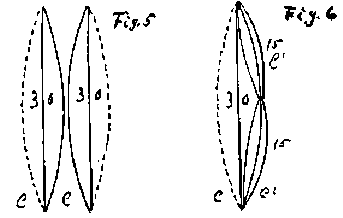
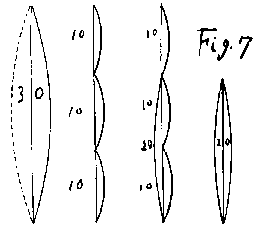
If the strings are vibrating at the rate of 100 and 101 per second, both starting at the same instant; it is plain that the 101 will gain in one-half of a second just one-half of a vibration, and in one second it will gain one vibration, which is equal to one beat, and the appearancs of the strings will be thus. See Fig. 5, page 28.
The beatings of the unisons are caused by the interference of the fundamental, that is by the string that is a trifle sharp or flat of the other.
While those of the octave of this fundamental are caused by the first overtone of the lower or fundamental with the fundamental of the upper. As one-half of the lower string's length is equal to the fundamental of the upper half of the string thus. See Fig 6, p. 28.
If the octave is pure the strings are vibrating at the same rate.
If not pure the number of beats will be in proportion of the error in tuning or difference in the number of vibrations per second. Beats in the fifth are caused by the interference of the second series of harmonics of the fundamental with the first series of the fifth.
By a careful examination of the diagram of harmonics this will be plain. We will also see that there is no length of string caused by a harmonic that produces the true fifth but that of the fifth above the octave, and as it is necessary that we use the true fifth in tuning, we must double the length of the string, which gives the harmonic fifth above the octave and will thus become twice its length or twenty inches for the true fifth as follows: See Fig 7, page 30.
It will be seen by the above diagram that the first harmonic of the fifth, viz.: its octave G is a perfect unison with the second harmonic of the fundamental C. If the interval be pure, then the second harmonic of the fundamental with the first harmonic of its fifth will coincide. If not pure the number of beats will be in proportion to the error in tuning or difference in the number of vibrations.
...
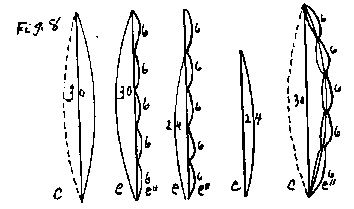
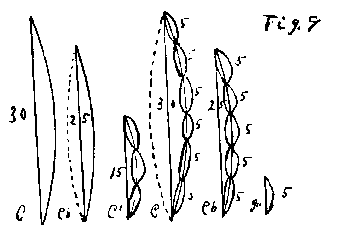
It is plain by the above diagram that the fifth harmonic of the fundamental small C is exactly the same as the second harmonic of its octave one lined C. As small C and one lined C are pure octaves, the fifth harmonic of small C and the second harmonic of one lined C will coincide, which gives a positive proof of the octave a minor third and a major sixth, showing that the harmonics of small and one lined C are vibrating at exactly the same rate.
The reason why we prove perfect consonant intervals is that as soon as the harmonics of the fundamentals of each are vibrating at almost the same rate, the stronger draws the weaker, which covers its beatings and causes it to blend before it is in exact pitch.
And by the use of a third or sixth whose beats are not less than five per second, we can immediately determine which is the false one. Also whether sharp or flat, as it is impossible for an interval to draw whose beats are five or more per second.
We are now prepared to understand why the fourth and fifth system added to the error of the drawing of the octave is not a safe or reliable one compared with the equal temperament which is the result of a correct tempering of the major and minor thirds, fourths, fifths and sixths.
...